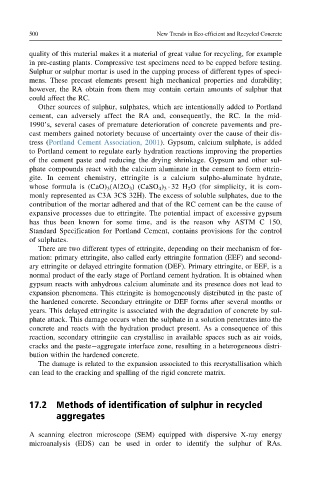Page 552 - New Trends in Eco efficient and Recycled Concrete
P. 552
500 New Trends in Eco-efficient and Recycled Concrete
quality of this material makes it a material of great value for recycling, for example
in pre-casting plants. Compressive test specimens need to be capped before testing.
Sulphur or sulphur mortar is used in the capping process of different types of speci-
mens. These precast elements present high mechanical properties and durability;
however, the RA obtain from them may contain certain amounts of sulphur that
could affect the RC.
Other sources of sulphur, sulphates, which are intentionally added to Portland
cement, can adversely affect the RA and, consequently, the RC. In the mid-
1990’s, several cases of premature deterioration of concrete pavements and pre-
cast members gained notoriety because of uncertainty over the cause of their dis-
tress (Portland Cement Association, 2001). Gypsum, calcium sulphate, is added
to Portland cement to regulate early hydration reactions improving the properties
of the cement paste and reducing the drying shrinkage. Gypsum and other sul-
phate compounds react with the calcium aluminate in the cement to form ettrin-
gite. In cement chemistry, ettringite is a calcium sulpho-aluminate hydrate,
whose formula is (CaO) 3 (Al2O 3 )(CaSO 4 ) 3 32 H 2 O (for simplicity, it is com-
monly represented as C3A 3CS 32H). The excess of soluble sulphates, due to the
contribution of the mortar adhered and that of the RC cement can be the cause of
expansive processes due to ettringite. The potential impact of excessive gypsum
has thus been known for some time, and is the reason why ASTM C 150,
Standard Specification for Portland Cement, contains provisions for the control
of sulphates.
There are two different types of ettringite, depending on their mechanism of for-
mation: primary ettringite, also called early ettringite formation (EEF) and second-
ary ettringite or delayed ettringite formation (DEF). Primary ettringite, or EEF, is a
normal product of the early stage of Portland cement hydration. It is obtained when
gypsum reacts with anhydrous calcium aluminate and its presence does not lead to
expansion phenomena. This ettringite is homogeneously distributed in the paste of
the hardened concrete. Secondary ettringite or DEF forms after several months or
years. This delayed ettringite is associated with the degradation of concrete by sul-
phate attack. This damage occurs when the sulphate in a solution penetrates into the
concrete and reacts with the hydration product present. As a consequence of this
reaction, secondary ettringite can crystallise in available spaces such as air voids,
cracks and the paste aggregate interface zone, resulting in a heterogeneous distri-
bution within the hardened concrete.
The damage is related to the expansion associated to this recrystallisation which
can lead to the cracking and spalling of the rigid concrete matrix.
17.2 Methods of identification of sulphur in recycled
aggregates
A scanning electron microscope (SEM) equipped with dispersive X-ray energy
microanalysis (EDS) can be used in order to identify the sulphur of RAs.

